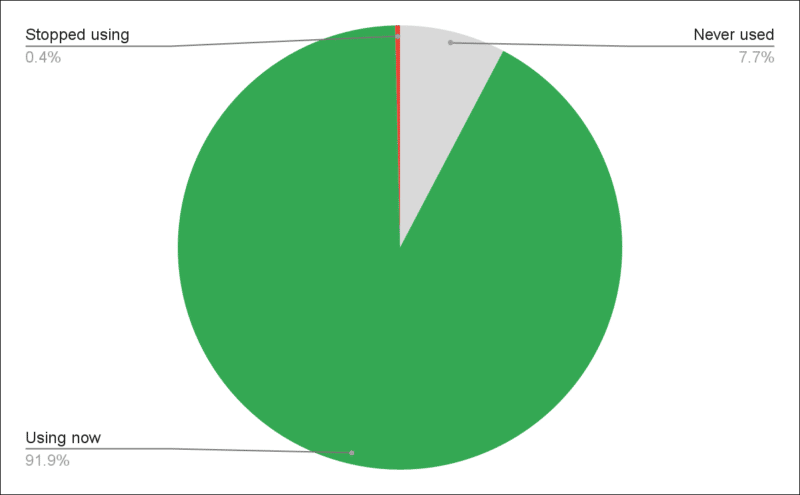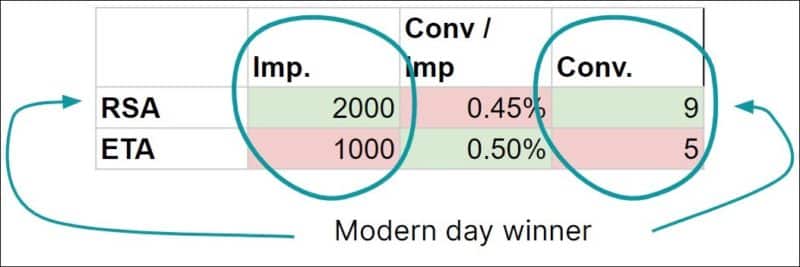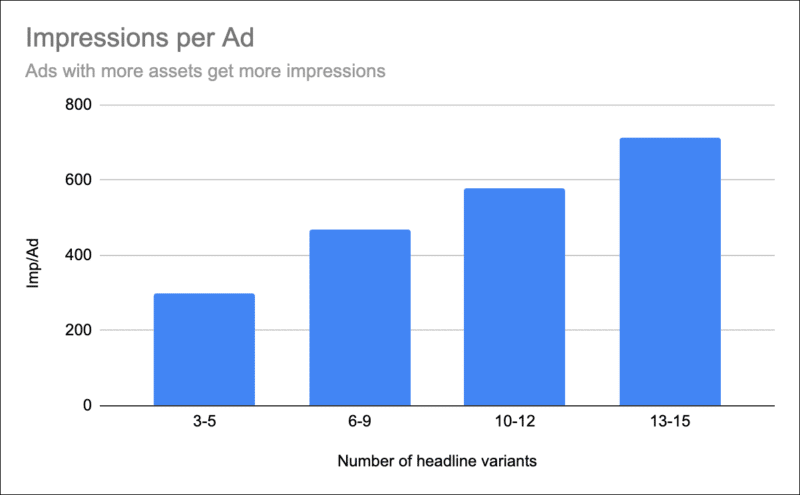
After years of perfecting ad optimization strategies for Expanded Text Ads (ETAs), advertisers must relearn optimization for Responsive Search Ads (RSA), the new text format of default ad on Google since July 2022. Due to its newness, a strong consensus on best optimization practices for RSA has yet to emerge. But there are known pitfalls that we already know to avoid.
Read on to learn about some of the most common mistakes advertisers make when working with RSA and how to use PPC management tools like the Google Ads UI or Optmyzr to prevent or solve them.
Layered automation puts humans in charge of improving PPC performance
RSA optimization follows a now-familiar pattern where the best results are achieved by leaning into automation rather than fighting it. This is the formula for success in the age of PPC automation that Optmyzr co-founder Fred Vallaeys shared in his book “Level the playing field”:
Machines + humans > machines alone
But with a looming recession and increased scrutiny on digital ad performance, PPC humans are poised to be even busier than they already are, and organizations may consider forgoing the important benefits humans can bring to results and rely only on ad engine automations. But for advertisers who want more results, more profit and less wasted ad spend, technology can come to the rescue in the form of layers of automation.
In the automation layers, humans create lightweight automations to take back control of the ad engine automations. Layers of automation can set safeguards and limits or feed proprietary data to Google’s sophisticated artificial intelligence that now controls much of what humans used to manage. Together, this makes PPC work better and faster while making fewer costly mistakes. The formula becomes:
Google AI Automations + human controlled automation layers > Google Automations alone
So let’s take a look at five of the most common mistakes we see with RSAs and how to fix them with layer automation.
1. We continue to rely on non-editable legacy ads
Just before sunset ETA, Optmyzr’s analysis of more than 13,000 Google Ads accounts found that 7.7% of advertisers had never yet created an RSA.
 Percentage of accounts that contain responsive search ads. Source: 2022 Optmyzr study of RSA performance of 13,671 randomly chosen Google Ads accounts.
Percentage of accounts that contain responsive search ads. Source: 2022 Optmyzr study of RSA performance of 13,671 randomly chosen Google Ads accounts.
Having only ETAs is risky because once they stop working as expected, they cannot be optimized. They also cannot be edited to reflect new promotions, which you will likely need to do as Q4 promotions roll out across the industry.
Part of the reason some advertisers still rely on non-editable ETAs is that it can be difficult to find ad groups that haven’t yet transitioned to RSAs. These ad groups simply continue to serve and may look good in reports, hiding the fact that they are serving with outdated ad formats.
To transition your final ad groups to RSA, scripts can be useful. Optmyzr has one RSA migration script which downloads all ad groups without RSA and pre-populates a bulk sheet with suggested ads. Since they’re in spreadsheet format, it’s much easier to quickly jump in and make changes before publishing them back to Google.
2. Ignoring your history of high performing campaigns
If you ran search campaigns in Google Ads before RSAs became the default ad type, you’re already ahead of everyone else starting now, especially if you’ve also followed some other best practice guidelines:
Using Automatic Bidding or Smart Bidding Appropriate use of seasonality adjustments Offline conversion imports
Older accounts also have an advantage because they have more data and the machines thrive on the data to learn patterns.
Advertisers transitioning from existing accounts can use their best performing ETA titles and descriptions to start new RSAs. This stock offers on average a 7% increase in conversions with a similar cost per conversion. This migration can be easily achieved with our RSA migration utility for Google and Microsoft.
3. Testing Responsive Search Ads by Conversion Rate
The biggest mistake, aside from ignoring RSAs entirely, is when advertisers treat their RSAs as ETAs during testing. RSAs have the unique ability to tailor what they display to increase their relevance to any incoming search query. Because they are designed to increase relevance on the fly, they have better quality scores and get many more impressions than ETA.
We found that ad groups with RSA got 2.1x more impressions than those without RSA. These additional impressions are why modern ad optimization strategies need to be reviewed and updated, as we’ll see below.
The old way of ad optimization favors the ad that delivers the most conversions per impression. But now that ads, and not just keywords, play an important role in determining potential impressions, impressions should also be factored into the analysis.
Look at the example below, where the ETA ad has about 10% better conversions per impression, but only gets half the impressions as the RSA. The bottom line is that the ETA ad generates fewer conversions, mainly because it gets far fewer impressions.

Old way: Focused on conversion rates or conversions per impression

New way: Focused on conversions within CPA or ROAS limits
At Optmyzr, advertisers control the algorithm that decides how ad A/B tests are decided. For example, you can limit the analysis to compare only ads that have a similar impression volume. By enabling this power user feature, you avoid pausing ads with fewer conversions per impression that would have gotten more conversions due to their very high impression volume.
4. Don’t experiment with pinning
As we said before, we believe that humans + machines > machines alone. In addition to writing asset bonds, pinning is another easy way for humans to control machines.
When pinning is taken to the extreme and one resource is pinned to each location, our study found the highest CTRs and conversion rates.

But before you nail down all the parts of your RSAs, don’t forget that high CTRs and high conversion rates are worthless without impressions. Unfortunately, the same pinning that produced a better CTR and conversion rate is responsible for limiting the impressions these ads get.
Google machines prefer when you allow them flexibility. For RSAs, we’ve found that impressions per ad increase as you give machines more options by adding more resources.

As for the impact of pinning only one resource per location, this results in significantly fewer impressions for RSA than when multiple resources are pinned to each location.

Pinning helps you control the machines, so use it to test ways to balance volume with quality. The best way to get meaningful statistical results is through the built-in use of Google ad variation tool which forms part of the framework of his experiments. Optmyzr users can accelerate their own experimentation using ours Campaign Experiments Dashboard to keep up with all the experiments you run across the many accounts and campaigns you manage.
5. Not matching RSAs with Smart Bidding and Broad Match
Automation likes it when advertisers remove limitations. We’ve seen this in the data above when impressions increase just by adding more ad text variations to an RSA. This is also true for removing other limitations. So when you want more conversions, carefully loosen the match types to allow RSAs to show your ads for even more queries.
We do not recommend a wholesale switch to broad matching. Instead, try paying close attention to your query data and adding negative keywords as needed. It even works for Performance Max campaigns that may have negative keywords, either by asking your Google representative to add them to the campaign or by adding them to a shared negative list associated with the Performance Max campaign.
But loosening the reins is only effective when you combine multiple tools for an effective automation strategy. Specifically, RSAs should be used in conjunction with automatic offers. Auto-bids can lower bids when they show an RSA for a query with weaker relevance to what your business sells.
Let’s illustrate it with an example. With a static max CPC bid of $5, the machine will bid $5 regardless of whether it thinks the user has a 20% or 80% chance of converting. In the case of the 20% probability, a $5 click means a CPA of $25 ($5 / 0.20), while with the 80% probability, it will be a CPA of $6.25 ($5 / 0.8). Smart bidding can take into account the difference in conversion probability between different queries and help achieve a more consistent ROAS or CPA.
conclusion
Google is adding more automations all the time, and RSAs can drive incremental conversions at a reasonable cost, especially when supplemented with other machine learning capabilities like Smart Bidding.
Optmyzr’s PPC Optimization Suite is evolving alongside Google and now offers a full range of capabilities to create, test and optimize RSA assets and the ad groups/campaigns in which they run. If you want to give it a try, take advantage of our free 14-day trial. .
To learn more about modern ad optimization, sign up for UnLevel to get access to free RSA-focused content from Anne Bui (Puffer), Zenia Johnson (Outside Inc), Jyll Saskin Gales (Jyll.ca) and many more.
New in Search Engine Land
About the author

Optmyzr’s PPC management platform provides intelligent optimization suggestions that help advertisers around the world manage their online advertising more effectively. Optmyzr connects with Google Ads, Microsoft Ads, Amazon Ads, Facebook Ads, Google Analytics, Google Merchant Center, Google Sheets and SA360. The company was founded by former Google AdWords executives. The Optmyzr PPC suite includes over 30 tools to improve quality score, manage manual and automatic bids, find new keywords, A/B test ads, create new campaigns, manage placements, automate budgeting, and automate reporting. Optmyzr was named Best PPC Management Software at the 2020 US, UK and Global Search Awards.
[ad_2]
Source link




